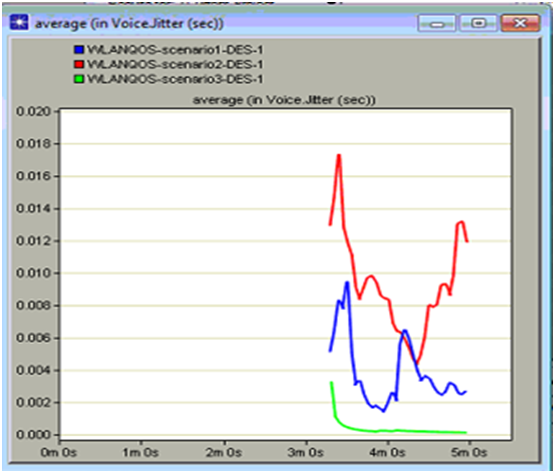Results and Analysis
Introduction
Simulation methods followed to create the required scenarios is explained in the previous chapter and after running the simulation for 5 minutes the respective results are achieved and they are given in this section. As mentioned three scenarios are created and the results of these three scenarios are compared against the DES metrics used are given in this chapter along the required quality of service evaluation. As three different types of voice applications are used in this project their performance in terms of quality of service is understood based on the results achieved and they are explained in detail in this chapter and the resultant graphs are also shown as below
Voice metrics
As the main aim of this QOS metrics for voice schemes across wireless LAN project is to evaluate the quality of service requirements for the voice applications across the MANET, few voice metrics as discussed in the previous chapter are compared for all the three scenarios designed in this section and they are given as below
Jitter
In general jitter indicates the packet delay variation and the packet delivery efficiency across the network and in this process the results from all the three scenarios are considered. First scenario uses the low quality speech, second scenario uses the IP telephony, and third scenario issues the GSM quality voice across the network and the quality of service metrics are estimated and jitter is one among them. In general low jitter indicates a good quality of service metrics and in this context the actual value is estimated as per the comparison graphs as shown below.
It is observed that the jitter imposed by the IP telephony is more when compared to the other scenarios and even the value is not constant throughout the simulation and there is lot of variations which indicates that there is lot of packet loss with the IP telephony. The overall performance of the GSM quality voice is better when compared to the other scenarios as the speech is suppressed and in this context the overall performance of the application has increased due this low jitter value and thus the quality of service is enhanced is many aspects.
The performance of low quality speech voice application is better than the IP telephony as the quality consumed by a simple speech application is very less and thus the noise across the speech is suppressed at a constant rate and thus the overall quality of service is enhanced. This value is more than the GSM quality as the propagation aspects followed across the GSM are inbuilt with the default quality metrics and thus the overall jitter is very less and constant throughout the simulation.
From this analysis it is clear that the overall quality of service can be improved with the low jitter value and in this context the speech noise depressed and thus GSM has shown a constant jitter and this indicates that the packet delay variation is constant and also the packet delivery is at the idle conditions and thus the overall quality of service is improved.

